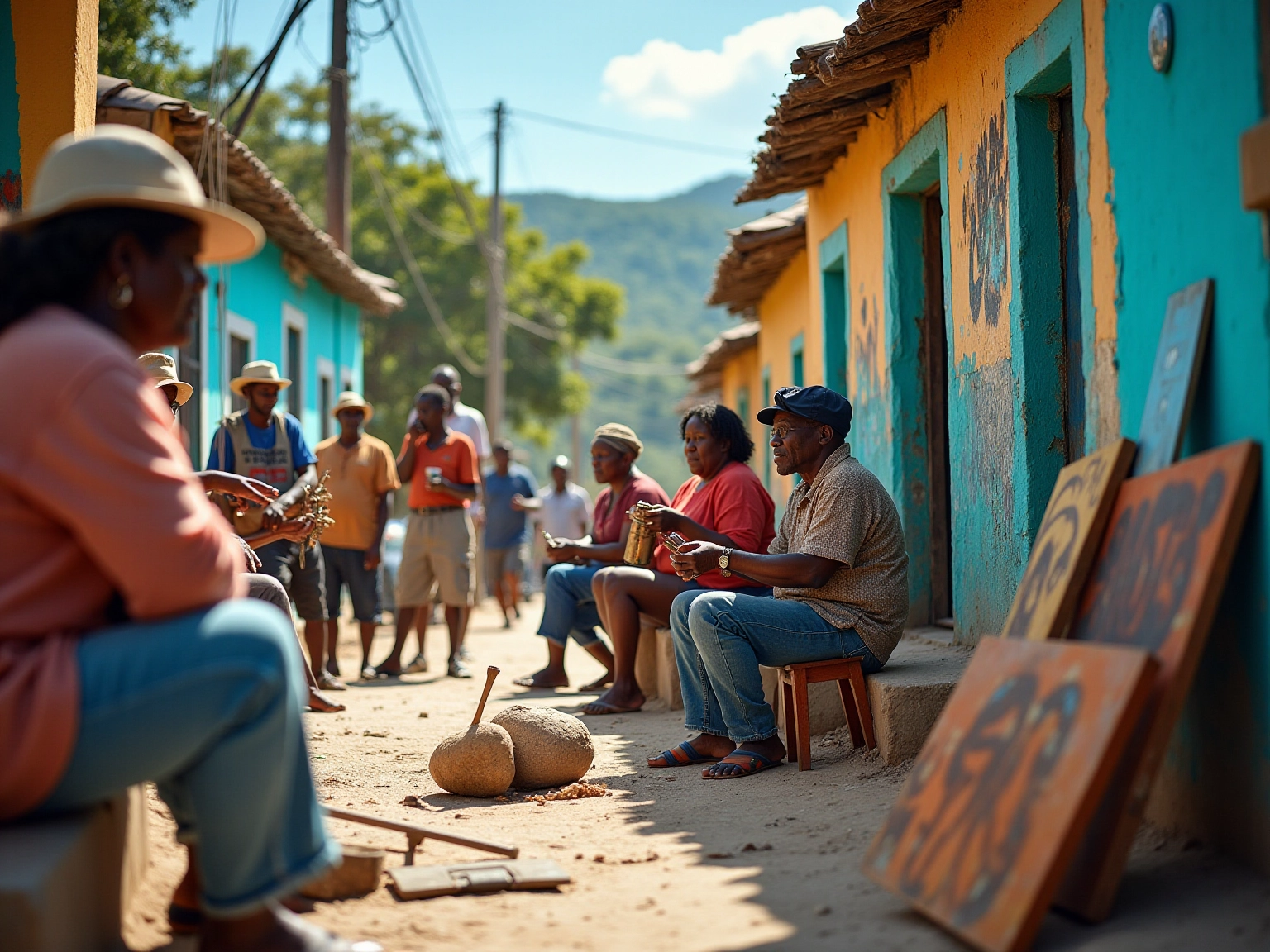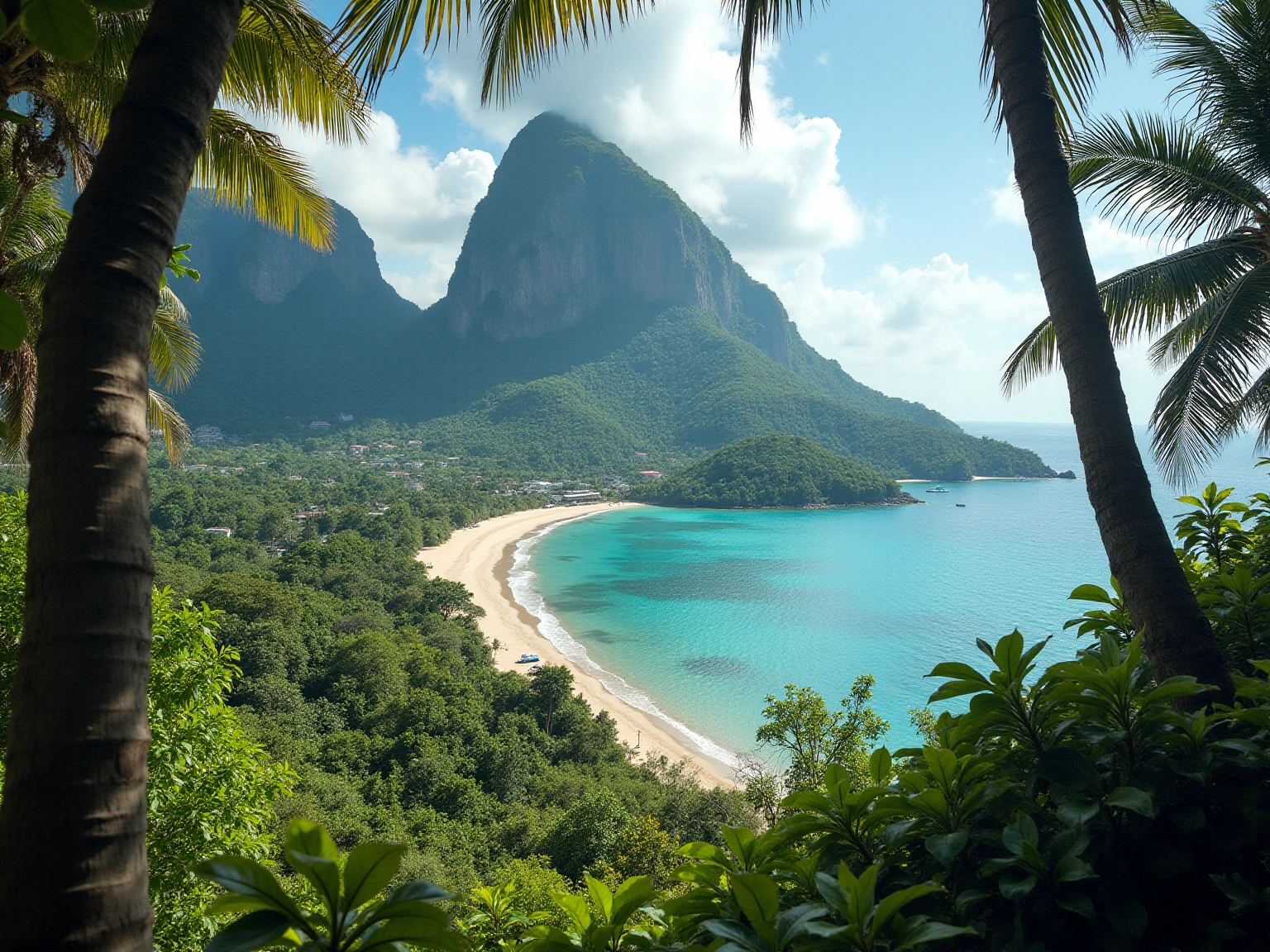Overview
Haiti is absolutely stunning! With its breathtaking landscapes, rich cultural heritage, and the warm hospitality of its people, it truly is a vibrant destination just waiting for you to discover. Despite facing challenges in the past, the tourism scene is making a comeback in 2025, focusing on cultural heritage and authentic experiences. You’ll want to check out key attractions like:
- Citadelle Laferrière
- The artistic vibrancy of Port-au-Prince
Together, these gems reveal the heart and soul of this incredible island. So, are you ready to explore?
Key Highlights:
- Haiti is a Caribbean nation known for its stunning landscapes, rich cultural heritage, and artistic expressions.
- Tourism is experiencing a resurgence in 2025, focusing on cultural heritage travel and authentic local experiences.
- Key attractions include Citadelle Laferrière and the vibrant streets of Port-au-Prince, showcasing architectural wonders.
- In 2019, Haiti welcomed approximately 938,000 international visitors, but tourism revenues fell significantly during the COVID-19 pandemic.
- Haiti’s history includes the Haitian Revolution, marking its identity as the first independent black republic, influencing contemporary travel.
- The country features diverse ecosystems and national parks, attracting nature lovers and promoting eco-tourism.
- Cultural vibrancy is evident in music, art, and festivals, with events like Carnival drawing thousands of attendees.
- Haitian cuisine, influenced by African, French, and indigenous cultures, is gaining popularity among culinary tourists.
- The hospitality of the Haitian people enhances the visitor experience, fostering community connections.
- Future tourism initiatives focus on improving infrastructure, sustainability, and community-based travel to attract visitors.
Introduction
Nestled in the vibrant Caribbean, Haiti is a captivating destination that often gets overshadowed by its complex past. With breathtaking landscapes, a rich cultural heritage, and an artistic spirit flourishing in every corner, this island invites you to explore its unique offerings. As tourism begins to rebound, travelers are discovering the allure of Haiti through immersive experiences that celebrate its history, music, and culinary delights.
From the architectural marvels of Citadelle Laferrière to the enchanting blue pools of Bassin Bleu, Haiti promises an adventure filled with authenticity and connection.
Let’s delve into the diverse attractions that make Haiti a hidden gem, highlighting the resilience of its people and the vibrant culture that awaits those willing to embark on a journey to this remarkable island.
The Allure of Haiti: A Hidden Gem in the Caribbean
This nation, often overlooked due to its complex history, emerges as a vibrant tapestry woven with culture, art, and Haiti’s stunning natural landscapes. Nestled in the heart of the Caribbean, Haiti showcases breathtaking scenery that ranges from lush, mountainous areas to pristine, sun-drenched shores. But its allure goes beyond just picturesque views; the nation’s rich cultural heritage is a captivating blend of African, French, and indigenous influences, creating a unique backdrop for you to seek authentic experiences.
In 2025, the country is experiencing a resurgence in tourism, focusing on cultural heritage travel that highlights the region’s artistic expressions. You can enjoy hands-on experiences, from spinning wheel demonstrations to live Cajun music performances, making it a fantastic destination for families and design enthusiasts alike. The museum also hosts community events and educational programs, allowing you to immerse yourself in the local culture through colorful murals, traditional crafts, and lively festivals that celebrate the region’s diverse history.
Key attractions like the Citadelle Laferrière and the vibrant streets of Port-au-Prince showcase the island’s architectural wonders and artistic essence.
In 2019, around 938,000 international visitors explored this beautiful destination, highlighting its potential as a travel hotspot. However, the COVID-19 pandemic significantly impacted the tourism sector, with revenues dropping from $450 million in 2019 to just $98 million in 2020. Despite these challenges, the average expenditure per tourist in 2021 bounced back to approximately $499, suggesting a slow recovery and renewed interest in the island.
As a hidden treasure in the Caribbean, this destination offers you a unique chance to connect deeply with its vibrant communities. The island’s artistic expressions invite exploration beyond the surface, revealing the heart and soul of the region. With tourism statistics indicating a gradual recovery, this blend of cultural richness and the beautiful aspects of Haiti positions the country as a must-visit destination for those eager to explore the world through a creative lens.
The Design Tourist enables you to discover these enriching travel experiences through storytelling and practical advice, making this destination an appealing choice for design enthusiasts. Don’t forget to share your adventures on social media to inspire others to uncover the beauty of this Caribbean nation!
A Rich Tapestry: The Complex History of Haiti
The history of this Caribbean nation is truly a captivating story of resilience and transformation, deeply rooted in its identity as the first independent black republic. The Haitian Revolution was a monumental event that liberated its people from slavery, marking a significant turning point not just for the nation, but also inspiring freedom movements around the world. However, this victory was followed by decades of political instability and economic challenges that often overshadow the island’s vibrant artistic contributions.
Despite these adversities, Haiti’s history is rich with a lively identity shaped through struggle. The blend of African traditions with French colonial influences has birthed a unique artistic heritage, evident in its music, dance, and visual arts. This cultural tapestry is not just a reflection of the past; it continues to evolve, showcasing the resilience of the Haitian spirit.
As Karen LeBlanc, a travel host and writer for The Design Tourist, emphasizes, every destination tells a story through its local art and culture, inviting you to engage with the authentic experiences that define a place.
As of 2025, the nation’s population reflects a complex demographic landscape, with significant portions facing challenges. This includes those with disabilities, representing about 15% of the community. The ongoing struggles for rights and access to services highlight the need for continued advocacy and support, as local organizations stress. In 2024, the situation worsened with reports of 168 detainees dying from malnutrition-related diseases, underscoring the urgent challenges many Haitians face.
The influence of the Haitian Revolution extends beyond historical importance; it has profoundly shaped contemporary travel. Visitors are increasingly drawn to Haiti’s stunning landscapes, rich heritage, and the narratives that shape its identity. This growing fascination with heritage tourism shows how understanding the nation’s history can help you appreciate the beautiful aspects of Haiti and the richness of its artistic landscape.
As noted by Tirana Hassan, the former Executive Director, “In 2024, the nation’s multidimensional crisis reached catastrophic levels,” highlighting the ongoing struggles that continue to affect the country.
In summary, Haiti’s journey is a testament to resilience, with its heritage serving as a beacon of hope and inspiration. The region’s artistic expressions, grounded in a rich history, showcase Haiti’s beautiful heritage and encourage you to explore and connect with the heart and soul of the nation. This makes it a destination of profound significance in the global cultural narrative. Through the lens of travel, as Karen LeBlanc suggests, you can uncover the authentic stories that deepen your understanding of this extraordinary place.

Natural Wonders: Exploring Haiti’s Stunning Landscapes
This nation showcases some of the most beautiful natural scenery in Haiti, offering a fascinating mix of environments that attract travelers from all over the world. Imagine towering peaks of the Massif de la Selle providing a dramatic backdrop for outdoor enthusiasts, while the pristine beaches of Jacmel invite you to relax and explore. Among the island’s highlights is the breathtaking Bassin Bleu, renowned for its crystal-clear waters and lush, tropical surroundings—definitely a must-visit destination for nature lovers!
In 2025, the national parks are set to display the nation’s rich biodiversity, highlighting distinctive flora and fauna that flourish in its diverse ecosystems. With over 1,500 species of plants and numerous endemic varieties, the natural heritage of this Caribbean paradise is both diverse and vital. The tropical climate enhances the island’s allure, offering year-round opportunities for outdoor adventures, from hiking through verdant mountains to snorkeling in vibrant coral reefs.
You can participate in various activities that showcase the natural beauty of the country, like guided hikes in La Visite National Park, where lush landscapes are home to a variety of wildlife. Eco-tourism projects are gaining momentum, encouraging sustainable practices that protect the country’s natural resources while providing enriching experiences for travelers. In 2025, national parks are expected to see a rise in visitor numbers, indicating a growing interest in discovering the country’s unique outdoor offerings.
In fact, annual visitation trends indicate a significant rise in recreational visits to national parks, showcasing the increasing appeal of these natural attractions.
Historically, the evolution of tourism in this Caribbean nation is fascinating. Back in 1904, national parks had only 67 visitors! This stark contrast highlights the growth and potential of eco-tourism in the region. Travel specialists emphasize the importance of exploring the national parks of the island, as they provide a glimpse into its ecological treasures.
As one expert noted, “Exploring these natural landscapes not only enhances the travel experience but also cultivates a deeper appreciation for the cultural stories connected with the region’s environment.” With its breathtaking scenery and commitment to preserving its natural heritage, Haiti stands out as a premier destination for those seeking adventure and beauty in the heart of the Caribbean. Additionally, looking at Barcelona, where tourism management strategies were implemented to preserve the quality of life for locals, it’s clear that emphasizing sustainable tourism practices is vital for harmonizing visitor experiences with environmental protection.

Cultural Vibrancy: The Heartbeat of Haitian Life
Haiti’s beautiful culture forms a vibrant tapestry woven from the threads of music, art, and festivals, each element reflecting the region’s rich heritage and communal spirit. The rhythmic beats of Kompa and Rara music resonate through the streets, inviting you to immerse yourself in the lively celebrations. In 2025, attendance at major cultural festivals, like Carnival and Fèt Gede, has seen a significant increase, drawing thousands eager to experience the essence and spirit of this amazing nation firsthand.
Art holds a central place in Haitian culture, showcasing colorful paintings and intricate sculptures that narrate the island’s history and spirit. The significance of art shines through the annual Art & Soul Gala, which raises essential funds for a medical clinic in Fiervil, benefiting thousands of families from isolated mountainous communities. This initiative not only addresses local health needs but also emphasizes the importance of art in promoting community resilience and pride.
Specialist perspectives highlight that music and art are essential to the nation’s identity, serving as influential means for storytelling and artistic expression. As Nelson Mandela famously stated, “Education is the most powerful weapon in the world!” This sentiment resonates deeply within the context of Haitian culture, where education and artistic expression are beautifully intertwined.
The macroeconomic landscape, while challenging, presents opportunities for local artists to thrive through digital platforms, bolstered by increased foreign remittances from the diaspora. This economic support enhances consumer spending on music, allowing Haitian artists to reach broader audiences and further enrich the cultural scene.
Cultural festivals in this Caribbean nation are not just entertainment; they are vital experiences that enhance your comprehension of the region’s identity. Engaging with these traditions offers a unique opportunity to connect with the local community, fostering meaningful interactions that resonate long after your journey ends. As you discover the vibrant art and music of Haiti, you unveil its heart and soul, making it a place that captivates and inspires.
Through the imaginative perspective of travel, as advocated by Karen LeBlanc and The Design Tourist, you are encouraged to value the authenticity and creativity that characterize Haiti’s artistic environment. Karen LeBlanc champions immersive experiences, emphasizing the importance of authentic accommodations and local art that tell the story of place, enriching your travel experience.
Culinary Delights: A Taste of Haiti’s Gastronomy
Haitian cuisine is like a vibrant tapestry, woven from the island’s rich heritage, showcasing the beautiful influences of African, French, and indigenous Taino cultures. Picture this culinary landscape, bursting with bold flavors and vibrant colors! Signature dishes like Griot (fried pork) and Joumou soup (pumpkin soup) stand out not just for their delightful taste but also for their profound significance. As we step into 2025, it’s exciting to see Haitian cuisine gaining popularity, especially among culinary tourists eager for genuine experiences.
On the streets, you’ll find fried foods known as fritaille (fritay), which beautifully showcase the local culinary culture and the dynamic street food scene. The use of fresh, locally sourced ingredients—including an array of tropical fruits and spices—elevates the culinary experience, making it a must-try for anyone visiting. Food plays a pivotal role in Haitian celebrations, serving as a unifying force that brings families and communities together.
For example, Joumou soup is traditionally enjoyed during New Year’s Day celebrations, symbolizing freedom and resilience. Isn’t that a beautiful way to connect food with cultural heritage?
As the demand for culinary tourism in the Caribbean grows, travelers like you are presented with unique opportunities to savor the region’s flavors while immersing yourselves in its rich cultural narratives. The evolving food market reflects this trend, shifting towards sustainable practices and locally sourced products, which enhances food security and promotes economic development. A recent case study highlights both the challenges and opportunities within this sector, emphasizing the growing demand for convenience food and locally sourced ingredients.
By exploring Haiti’s culinary scene, you not only indulge in exquisite dishes but also connect with the heart and soul of this beautiful region, making your travel experiences truly unforgettable. Interestingly, you can draw parallels with Cuba’s emerging culinary scene, where innovative restaurants are reinterpreting traditional dishes, much like in Haiti. As noted by the Director of Strategic Marketing and Innovation at Biospringer, this evolving culinary landscape is influenced by innovations in taste and texture solutions, particularly in plant-based foods, tying into broader trends in both Haitian and Cuban cuisine.
With extensive global consumer data and marketing efforts backing it up, interest in Haitian cuisine among culinary tourists is on the rise, creating an exhilarating opportunity to discover the flavors of the region alongside the vibrant culinary offerings of Cuba. So, are you ready to dive into this culinary adventure?
The Warmth of the People: Hospitality in Haiti
The allure of Haiti shines through in the warmth and hospitality of its people, making it truly beautiful. Known for their friendliness and generosity, Haitians greet visitors with open arms, embodying a welcoming spirit that enriches your experience. This sense of hospitality is woven into the culture, where community and family ties are of utmost importance.
As you explore, you might find yourself sharing meals or joining in lively local festivities, creating connections that go beyond the typical tourist experience. Engaging with the local community not only enhances your journey but also deepens your appreciation for Haiti’s rich culture and traditions. As Karen LeBlanc highlights in The Design Tourist, every destination tells its story through local art, architecture, and customs, so it’s essential to embrace these elements during your travels.
In 2021, despite the challenges brought on by the COVID-19 pandemic, tourists spent an average of about 499 USD each. However, this was during a significant drop in travel revenue, which plummeted from 450 million USD in 2019 to just 80 million USD in 2021. This stark contrast underscores the pandemic’s impact on the travel industry in this Caribbean nation, highlighting the importance of community involvement to foster mutual respect and understanding between visitors and locals.
Moreover, the resilience and strength of the Haitian spirit shine through in these interactions, making every visit a beautiful and heartwarming adventure. To capture these moments authentically, consider the best times for photography, like early mornings, and think about incorporating local attire or symbols into your photos, as LeBlanc suggests. Remember, most national parks require permits for professional photography, so checking local regulations and securing necessary permits ahead of time is crucial.
Props like balloons or bicycles can add a personal touch to your travel photography, enhancing the storytelling aspect. As travel in Haiti evolves, the focus on community involvement remains vital, showcasing how local hospitality can transform your experience into something truly unforgettable. With a current user penetration rate of 9.9% in the hotel market, there’s significant potential for growth in this sector, especially as the country aims to rebuild and enhance its hospitality offerings.
Interestingly, Haiti ranks 124th worldwide in terms of tourists per resident, with only 0.013 visitors for each inhabitant, highlighting the challenges it faces in attracting tourists relative to its population. Historically, in 1995, the nation welcomed 145,000 tourists, generating receipts of 90 million USD, illustrating how its tourism landscape has evolved over the years. This context enriches the narrative of current hospitality and community engagement, aligning perfectly with the blog’s mission to blend expert storytelling with practical travel advice.
Discovering Haiti: Attractions and Experiences Await
Haiti, a stunning Caribbean gem, is brimming with attractions that cater to a wide array of interests, making it a must-visit destination for travelers like you who seek both beauty and authenticity. At the forefront is the historic Citadelle Laferrière, a UNESCO World Heritage site that stands as a testament to the island’s rich history and architectural prowess. This iconic fortress not only offers breathtaking views but also symbolizes the nation’s resilience and heritage, reflecting the intricate stories that define the country.
In the vibrant capital of Port-au-Prince, you can dive into a thriving art scene, where local artists showcase their talents through colorful paintings, sculptures, and crafts. The city’s markets buzz with the sounds and sights of daily life, providing an authentic glimpse into Haitian culture and the chance to pick up unique handmade souvenirs that capture the essence of the island.
For nature lovers, Haiti is a paradise, featuring awe-inspiring natural wonders like the Bassin Bleu, a collection of captivating blue pools surrounded by lush vegetation—perfect for a refreshing swim or a peaceful hike. The island’s national parks, part of Haiti’s beautiful landscapes, invite you to explore diverse ecosystems, from tropical forests to mountainous terrains, allowing adventurers to connect with the stunning scenery that inspires creativity and reflection. If you’re a history buff, you’ll find a treasure trove of narratives waiting to be uncovered at various museums and cultural sites across the island. These locations not only highlight the country’s rich history but also celebrate its vibrant current state, showcasing the strength and inventiveness of its people through art and design.
Despite the challenges faced by the travel industry, which saw a significant drop in visitor numbers from 1 million travelers in 2018 to just 148,000 in 2021 due to the pandemic, the average expenditure per traveler in 2021 was around 499 USD. This indicates that those who do visit contribute significantly to the local economy, with travel generating approximately 80 million USD in 2021, representing 0.40% of the nation’s GDP. As the travel landscape continues to evolve in 2025, Haiti remains a location ripe for exploration, inviting you to embark on an adventure filled with discovery, connection, and a deeper appreciation for its heart and soul, echoing the insights of Karen LeBlanc on the importance of experiential learning in travel.
The Design Tourist emphasizes the significance of these experiences, encouraging you to engage with the local culture and architecture.

Looking Ahead: The Future of Tourism in Haiti
The future of travel in Haiti is brimming with promise, even in the face of ongoing challenges. As you seek authentic and immersive experiences, Haiti’s rich cultural tapestry and breathtaking landscapes make it a truly beautiful destination. Travel host and writer Karen LeBlanc highlights that every place has a story to tell through its local art, architecture, and traditions.
This perspective is especially important as Haiti enhances its travel offerings to attract a new generation of visitors eager to explore its wonders.
Recent government initiatives aimed at improving travel infrastructure, safety, and sustainable practices are vital for revitalizing the tourism sector. The Haitian administration is actively investing in hospitality training and marketing efforts, recognizing that the travel industry plays a crucial role in economic growth. Community-based travel is becoming a focal point, allowing you to engage directly with local cultures and traditions.
This approach not only preserves the nation’s unique heritage but also empowers local communities, fostering economic development from within.
The resilience of the Haitian people, coupled with strategic initiatives, positions the island to draw in visitors who appreciate genuine experiences. Did you know that by 2025, the global flights market is projected to generate significant revenue, with the United States leading at around $146 billion? This trend shows a growing desire for travel, and Haiti can capitalize on this by enhancing its offerings.
Moreover, sustainable travel initiatives are gaining traction, with various case studies showcasing successful projects that prioritize environmental stewardship and heritage preservation. As Richecard Cine, the founding president, noted, “The Jacmel Jazz Festival, one of the most anticipated events of the year, is back with its 8th edition!” Events like this not only attract visitors but also highlight the vibrant local culture, echoing LeBlanc’s belief in the power of storytelling through travel.
Additionally, macroeconomic factors like global economic stability and currency rates significantly influence travel demand in the region, making it essential to consider these elements within the broader industry context. As Haiti continues to enhance its tourism infrastructure and embrace sustainable practices, the island is set to become a vibrant hub for cultural exploration and adventure, inviting you to uncover the heart and soul of this beautiful destination.
Conclusion
Haiti is a captivating testament to resilience, rich culture, and stunning natural beauty, inviting you to explore its hidden gems! From the historic Citadelle Laferrière to the vibrant streets of Port-au-Prince, this island offers a wealth of attractions that reflect its complex history and artistic spirit. The resurgence of tourism, especially in cultural heritage travel, highlights a growing interest in authentic experiences that connect you with the heart and soul of Haiti.
The island’s diverse offerings, including breathtaking landscapes, vibrant music and art scenes, and delectable cuisine, create a multifaceted travel experience. Engaging with local communities not only enriches your journey but also fosters a deeper appreciation for Haiti’s cultural narratives and the warmth of its people. As tourism continues to evolve, the emphasis on sustainable practices and community engagement remains paramount, ensuring that both you and the residents benefit from the island’s unique charm.
Looking ahead, the future of tourism in Haiti is promising, driven by strategic initiatives aimed at enhancing infrastructure and promoting cultural experiences. As you seek immersive adventures, Haiti’s vibrant tapestry of culture and natural beauty positions it as a must-visit destination. Embracing this opportunity will not only revive the tourism sector but also celebrate the resilience and creativity that define the Haitian spirit, inviting you to discover the treasures that await on this remarkable island!
Frequently Asked Questions
What makes Haiti a unique travel destination?
Haiti is unique due to its vibrant cultural heritage, which is a blend of African, French, and indigenous influences, alongside its stunning natural landscapes that include lush mountains and sun-drenched shores.
What are some key attractions in Haiti?
Key attractions include the Citadelle Laferrière and the vibrant streets of Port-au-Prince, which showcase the island’s architectural wonders and artistic essence.
How has tourism in Haiti changed in recent years?
In 2019, Haiti welcomed around 938,000 international visitors, but the COVID-19 pandemic significantly impacted tourism, with revenues dropping from $450 million in 2019 to $98 million in 2020. However, by 2021, the average expenditure per tourist rebounded to approximately $499, indicating a slow recovery.
What types of cultural experiences can visitors expect in Haiti?
Visitors can enjoy hands-on experiences such as spinning wheel demonstrations and live Cajun music performances, as well as community events, educational programs, colorful murals, traditional crafts, and lively festivals.
How does Haiti’s history influence its culture today?
Haiti’s history, particularly the Haitian Revolution that led to its independence as the first black republic, has shaped its cultural identity. Despite facing political instability and economic challenges, the blend of African traditions and French colonial influences continues to evolve, reflecting the resilience of the Haitian spirit.
What challenges does Haiti currently face?
Haiti faces ongoing challenges, including significant struggles for rights and access to services for various communities, including people with disabilities. Reports of malnutrition-related diseases and a multidimensional crisis highlight the urgent issues affecting many Haitians.
Why is heritage tourism important in Haiti?
Heritage tourism is important as it allows visitors to appreciate Haiti’s stunning landscapes and rich cultural heritage while understanding the historical narratives that shape its identity, thus fostering a deeper connection with the nation.
How can travelers engage with Haiti’s local culture?
Travelers can engage with Haiti’s local culture through authentic experiences offered by local art, music, and festivals, which invite exploration of the region’s heart and soul.


































